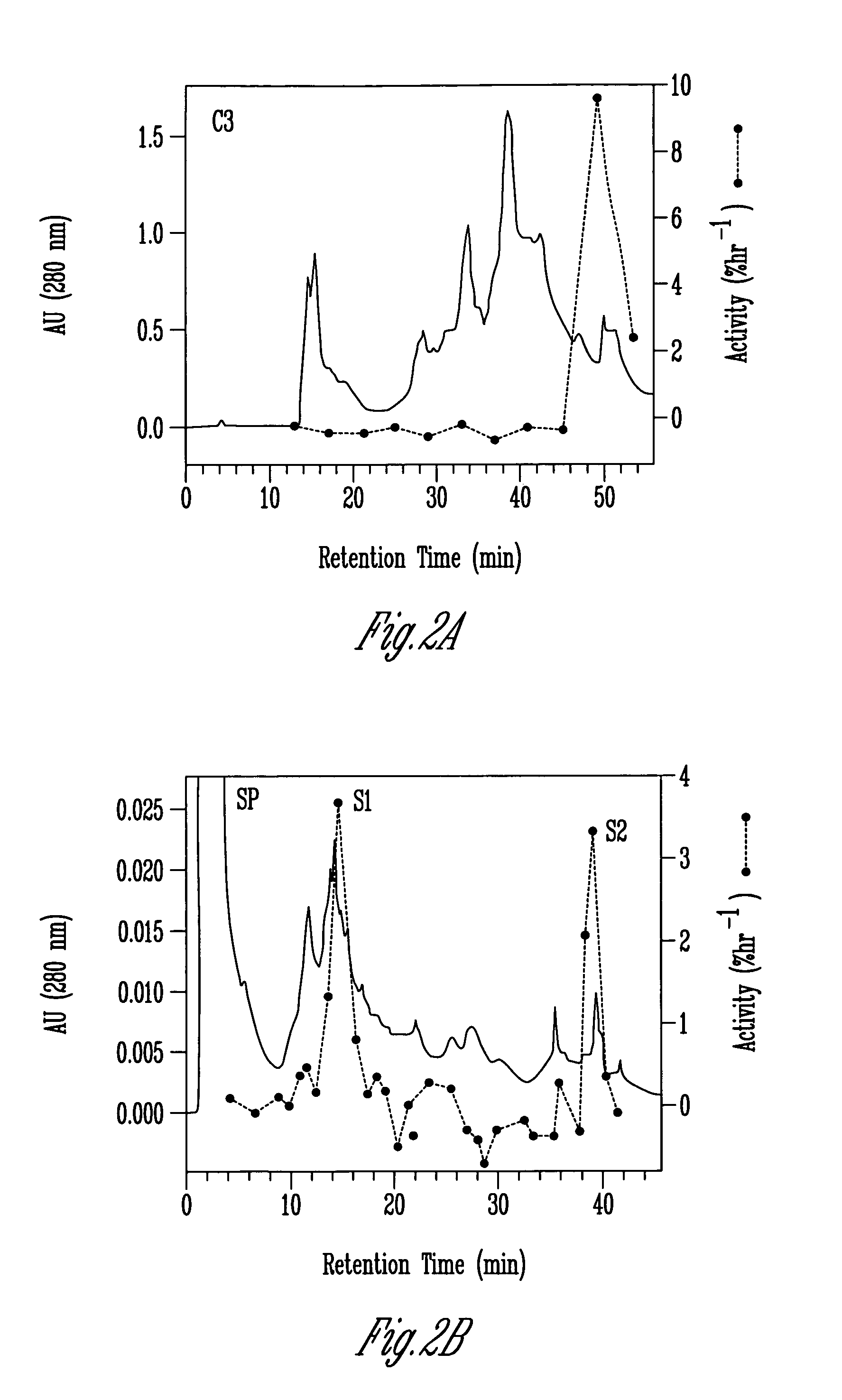Purified plant expansin proteins and DNA encoding same
a technology of purified plant expansin and dna encoding, applied in the field of proteins, can solve the problems of significant limitation in current paper recycling operations, and achieve the effect of increasing the relaxation rate of paper strips
- Summary
- Abstract
- Description
- Claims
- Application Information
AI Technical Summary
Benefits of technology
Problems solved by technology
Method used
Image
Examples
example 1
Preparation of Plant Materials
[0116]Seeds of cucumber (Cucumis sativus cv Burpee Pickler) were sown on Seed Germination Kimpack Paper K-22 (Seedburro Equipment Corporation, Chicago, Ill.) soaked with distilled water, in flats, 50×25×6 cm, with lids of the same dimensions. Seedlings were grown in the dark for 4 days at 27° C. The apical 3 cm of hypocotyl was excised and frozen at −20° C. for no more than 5 days and prepared for creep measurements as previously described (Cosgrove 1989). For bulk wall extractions, the apical 3-cm hypocotyl regions were collected on ice water and homogenized with 25 mM sodium acetate, 2 mM EDTA, pH 4.5 in a Waring blender. The wall fragments were collected and washed twice by filtration through Miracloth and subsequently used for protein extraction. Basal walls were from the lower 6 cm of the (15 cm long) hypocotyls.
[0117]Oat seedlings were grown in moist vermiculite in complete darkness at 27° C. Except as noted, coleoptiles were from 4-day old oat se...
example 2
Isolation of Expansins cEx-29 and cEx-30 from Cucumber Protein Extraction
[0120]Washed cucumber cell wall fragments (from 150–200 g of tissue) were extracted overnight in 20 mM Hepes, pH 6.8, 1 M NaCl at 4° C. Cell wall fragments were-filtered on Miracloth and the salt-solubilized fraction precipitated with ammonium sulfate (the activity precipitated between 20 and 60% saturation with [NH4]2SO4). The precipitate was desalted on a 7-mL column of Bio-Gel P2 (BioRad Laboratories) into 50 mM sodium acetate, pH 4.5. Protein concentration was 2 to 4 mg / mL, estimated by Coomassie Protein Assay Reagent (Pierce, Rockford, Ill.).
[0121]For the comparison of soluble and wall associated proteins, 100 g of tissue was harvested and homogenized with 100 mL of 25 mM sodium acetate, pH 4.5, 1 mM EDTA. Wall fragments were filtered out and the remaining solution designated as the soluble fraction. Wall fragments were cleaned as described above, and then extracted in 200 mL of 20 mM Hepes, pH 6.8, 1 M Na...
example 3
Isolation of Expansins oEx-29 from Oat Protein Extraction
[0125]For oat protein extraction, oat seedlings were rapidly cut under room lights and placed in ice water. The apical 2.5 cm (+1–0.5 cm) of each coleoptile was then cut, separated from the primary leaf, and placed on ice while the other coleoptiles were harvested. About 500 coleoptiles were homogenized in 200 mL of 10 mM sodium phosphate, pH 6.0. In some instances the coleoptiles were collected in lots of 100–200 and frozen (−20° C.) for 1 to 3 days prior to homogenization. The homogenate was filtered through a nylon screen (70 mm mesh), and the cell walls were collected and washed 4 times by resuspending in the homogenization buffer (300 mL) followed by filtration. lonically-bound proteins were extracted for at least 1 hour at 4° C. with 50 mL of 1 M NaCl containing 20 mM Hepes (pH 6.8), 2 mM EDTA and 3 mM sodium metabisulfite. Wall fragments were removed by filtration or centrifugation and the wall proteins in the supernata...
PUM
| Property | Measurement | Unit |
|---|---|---|
| length | aaaaa | aaaaa |
| pH | aaaaa | aaaaa |
| pH | aaaaa | aaaaa |
Abstract
Description
Claims
Application Information
 Login to View More
Login to View More - R&D
- Intellectual Property
- Life Sciences
- Materials
- Tech Scout
- Unparalleled Data Quality
- Higher Quality Content
- 60% Fewer Hallucinations
Browse by: Latest US Patents, China's latest patents, Technical Efficacy Thesaurus, Application Domain, Technology Topic, Popular Technical Reports.
© 2025 PatSnap. All rights reserved.Legal|Privacy policy|Modern Slavery Act Transparency Statement|Sitemap|About US| Contact US: help@patsnap.com



